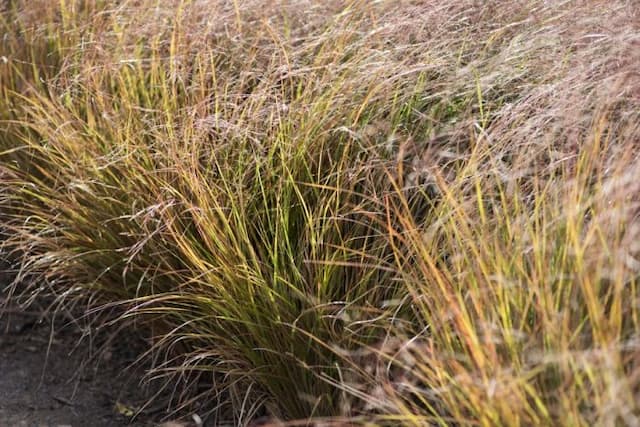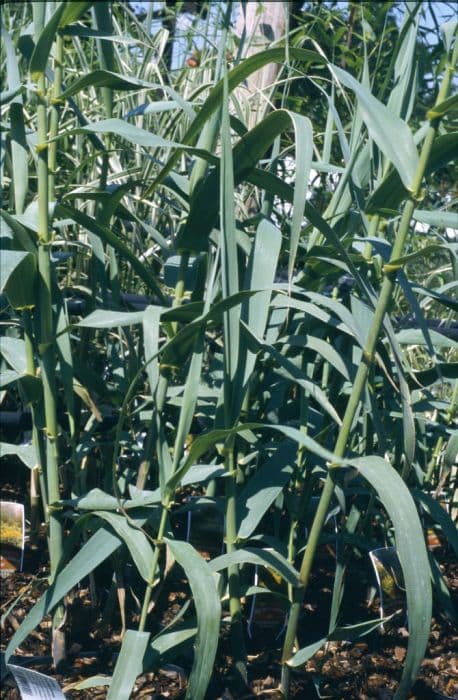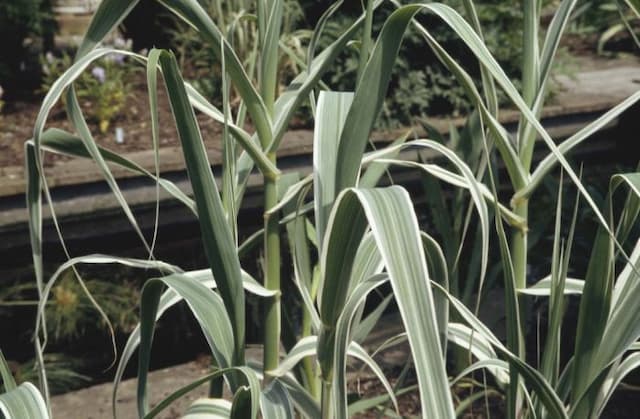Giant Feather Grass Stipa gigantea 'Pixie'

ABOUT
The plant known as 'Pixie' is a grass that sports a fine texture and an elegant, graceful form. It is a smaller variety that features narrow, arching green leaves which form a dense, fountain-like clump. During the late spring to early summer period, it showcases spectacular feathery plumes. The plumes start off with a purplish-green hue when young and mature into an attractive golden color, providing a beautiful contrast against the green foliage. These feathery plumes glisten when they catch the sunlight, adding a striking visual interest to gardens. With its long and showy panicles that hold aloft above the foliage, 'Pixie' brings an air of sophistication and movement to the landscape as they sway with the breeze. The plant maintains interest well into the winter, as the foliage browns and the dried flower heads continue to provide structural beauty even in dormancy.
About this plant
 Names
NamesFamily
Poaceae
Synonyms
Giant Feather Grass, Golden Oats
Common names
Celtica gigantea, Macrochloa gigantea, Stipa gigantea.
 Toxicity
ToxicityTo humans
Giant feather grass is generally not toxic to humans. If ingested, it is not known to cause poisoning or serious harmful effects. However, it is always advisable to avoid ingesting plants that are not specifically meant for consumption as a precautionary measure.
To pets
Giant feather grass is also generally considered non-toxic to pets. Ingesting this plant should not cause poisoning or any serious health issues in animals. As with humans, it's always best for pets to avoid eating ornamental plants.
 Characteristics
CharacteristicsLife cycle
Perennials
Foliage type
Semi-deciduous
Color of leaves
Green
Flower color
Golden
Height
4 feet (1.2 meters)
Spread
2 feet (0.6 meters)
Plant type
Grass
Hardiness zones
7
Native area
Iberian Peninsula
Benefits
 General Benefits
General Benefits- Low Maintenance: Requires minimal care once established, making it an excellent choice for gardeners who prefer low-maintenance plants.
- Drought Tolerance: Adapted to survive periods of low water availability, which is beneficial in arid or drought-prone regions.
- Attracts Wildlife: Produces seeds that attract birds, adding to the biodiversity of the garden.
- Ornamental Appeal: Offers striking visual interest with its tall, graceful stems and feathery inflorescences, enhancing garden aesthetics.
- Architectural Structure: Provides a strong vertical element in garden design, useful for creating depth and contrast in planting schemes.
- Seasonal Interest: Features a long period of interest from summer into winter, with foliage and seed heads providing texture and movement even in colder months.
- Naturalistic Planting: Ideal for use in prairie-style or naturalistic planting designs, blending well with other grasses and perennials.
 Medical Properties
Medical PropertiesThis plant is not used for medical purposes.
 Air-purifying Qualities
Air-purifying QualitiesThis plant is not specifically known for air purifying qualities.
 Other Uses
Other Uses- Acoustical Improvement: Stipa gigantea 'Pixie', also known as Giant Feather Grass, can be used to reduce noise pollution and improve acoustics in a garden setting due to its dense foliage and tall flowers.
- Photography Enhancement: The whimsical appearance of the Giant Feather Grass's tall, feathery plumes makes it a popular choice among photographers for adding texture and interest to garden and landscape photos.
- Educational Tool: In schools or community programs, Giant Feather Grass can be used to teach children about plant life cycles, from germination to seed production.
- Seasonal Decor: Its dried flower stems can be gathered and used for creating autumnal or wintery decorations for homes or events.
- Visual Screening: Its tall growth habit allows Giant Feather Grass to be used as a natural and aesthetically pleasing screen, providing privacy in the garden without the need for fences.
- Floral Arrangements: The striking flowers and seed heads of Giant Feather Grass can be used in dried floral arrangements to add height and movement.
- Thematic Gardens: This grass can be included in Mediterranean or dry landscape gardens as it reflects the aesthetic and thrives in similar conditions.
- Wildlife Habitat: It can offer habitat and food for small wildlife, including birds that feed on its seeds and insects that find shelter within its foliage.
- Erosion Control: The root system of Giant Feather Grass can help stabilize soil on slopes, preventing erosion.
- Craft Material: The strong stems of the plant can be used in crafts, such as making natural weavings or as stakes in garden projects.
Interesting Facts
 Feng Shui
Feng ShuiThe Giant Feather Grass is not used in Feng Shui practice.
 Zodiac Sign Compitability
Zodiac Sign CompitabilityThe Giant Feather Grass is not used in astrology practice.
 Plant Symbolism
Plant Symbolism- Elegance: Stipa gigantea, also known as Giant Feather Grass, often symbolizes elegance due to its tall, graceful stems and feathery plumes that sway gently in the breeze.
- Resilience: As a hardy plant that can withstand various climates and soils, Giant Feather Grass represents resilience and the ability to adapt and thrive in different conditions.
- Movement: The free-flowing nature of the grass's plumes is reminiscent of movement and change, symbolizing the flow of life and the embrace of change.
- Lightness: The delicate and airy appearance of the plumes gives Giant Feather Grass a symbolic association with lightness and the lifting of burdens or light-heartedness.
- Simplicity: This plant's simple form and the unadorned beauty of its plumes can signify simplicity and a focus on the inherent beauty of the natural world.
 Water
WaterGiant Feather Grass, also known as Stipa gigantea 'Pixie', does not require frequent watering once established as it is drought-tolerant. For young plants, water deeply once a week to help root establishment. Once matured, watering can be reduced, generally providing 1 inch of water every two to three weeks during dry periods. During the growing season, make sure the soil is not waterlogged, and in winter, reduce watering further to prevent root rot. It can be beneficial to use a rainfall gauge to monitor natural rainfall and adjust supplemental watering accordingly, aiming for a total of 1 inch of water including rainfall.
 Light
LightGiant Feather Grass prefers a location that offers full sun exposure for most of the day as this encourages the plant to grow tall and produce its characteristic feathery blooms. However, it can also tolerate partial shade, although flowering might not be as abundant. The ideal spot for this ornamental grass is one that receives at least six hours of direct sunlight daily, avoiding heavily shaded areas to maintain its vigor and aesthetic appeal.
 Temperature
TemperatureGiant Feather Grass is hardy and can tolerate a wide range of temperatures, generally thriving in conditions between 40 and 85 degrees Fahrenheit. The plant is cold hardy down to around 20 degrees Fahrenheit and can survive brief periods of colder temperatures. To maintain optimal growth, avoid exposing it to prolonged temperatures below freezing or excessive heat above 90 degrees Fahrenheit, as this can stress the plant or inhibit its growth.
 Pruning
PruningPruning Giant Feather Grass helps to maintain its shape and removes any dead or damaged foliage. It should be pruned in late winter or early spring before new growth begins. Cut the plant back to about 6 inches to allow for fresh growth while keeping the base intact. This is typically done once a year, usually just as the frost season ends, making it ready for the upcoming growth season.
 Cleaning
CleaningAs needed
 Soil
SoilGiant Feather Grass thrives in well-draining soil with medium fertility, preferably a mix of loam and sand. The soil pH should be neutral to slightly acidic, ideally between 6.0 and 7.0.
 Repotting
RepottingGiant Feather Grass, being a grass, generally does not need frequent repotting. It can be repotted every 2 to 3 years to refresh the soil or if it has outgrown its current container.
 Humidity & Misting
Humidity & MistingGiant Feather Grass prefers a dry to average humidity level and can tolerate some drought, reflecting its natural grassland habitat.
 Suitable locations
Suitable locationsIndoor
Ensure full sun, well-draining soil, and good air circulation.
Outdoor
Choose a sunny spot, well-draining soil, and space to grow.
Hardiness zone
7-10 USDA
 Life cycle
Life cycleStipa gigantea 'Pixie', commonly known as Giant Feather Grass or Golden Oats, begins its life cycle with seed germination, typically in the spring, when the soil temperature and moisture levels are conducive to growth. The seeds establish a root system and a tuft of foliage that grows into a compact clump of fine, arching leaves. As the plant matures, usually in late spring to early summer, it sends up tall, graceful flowering stems that tower above the foliage, with panicles of oat-like flowers that turn from green to a golden hue as they age. After pollination, the flowers produce seeds that mature by late summer to early fall, which can be dispersed by wind or wildlife. In winter, the plant's above-ground parts may die back, but the roots remain alive, allowing it to enter a period of dormancy before resuming growth in the next spring. This perennial grass may live for several years, going through the same cycle annually, with some self-sowing to propagate new plants.
 Propogation
PropogationPropogation time
Early Spring
Propogation: The most popular method of propagation for the Stipa gigantea 'Pixie', also known as Giant Feather Grass, is through seed collection and sowing. The optimal time for seed collection is late summer when the seeds have matured but before they have dispersed. To propagate, collect the seeds by gently shaking the flower stems over a container to dislodge them. Sow seeds immediately or store them in a cool, dry place until the spring. For spring sowing, distribute the seeds sparingly over the surface of a well-drained seed starting mix and press them lightly into the soil, but do not cover them as they need light to germinate. Keep the soil moist, and germination should occur within 2 to 3 weeks at a temperature around 68 degrees Fahrenheit (20 degrees Celsius). Once the seedlings have developed true leaves and are large enough to handle, they can be transplanted to their final positions in well-drained soil in full sun.









